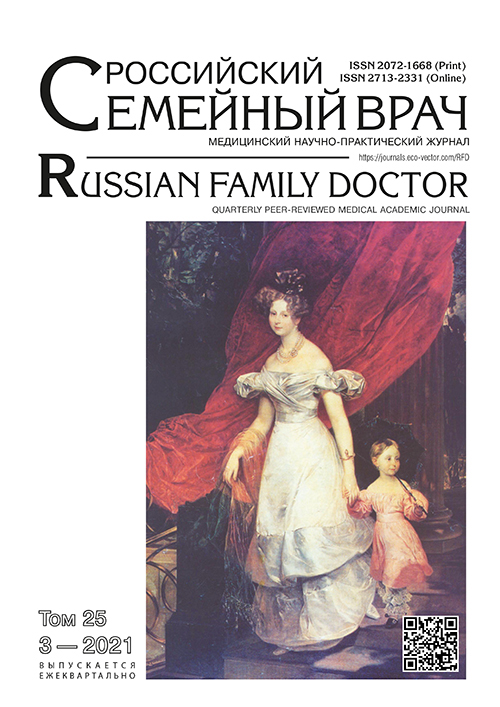卷 25, 编号 3 (2021)
- 年: 2021
- ##issue.datePublished##: 18.11.2021
- 文章: 5
- URL: https://journals.eco-vector.com/RFD/issue/view/4180
- DOI: https://doi.org/10.17816/RFD.20213
Lectures
老年医学的现状与展望
摘要
本文是一篇关于老年医学发展历史和现状的讲座。讲座的目的是考虑老年病学作为一门科学和临床学科的形成阶段,并证实其重要性。该讲座定义了诸如整体方法、复杂老年评估、老年综合征等概念。文中描述了国际和国内老年病学创始人的角色,包括M. Warren、B. Isaacs、D. Sheldon、I.I. Mechnikov、 V.N. Anisimov、E.S. Pushkov。考虑了老年医学的各个方向,并对科学研究的结果进行了分析。本文阐述了对成功治疗老年骨折患者至关重要的同体老年医学方法的基本原则,以及老年康复和老年心脏病学的特点。最后,作者提出了老年医学发展的几种模式。
 7-16
7-16


Review
新型冠状病毒感染大流行中风湿病共病患者的管理和疫苗接种特点
摘要
本文综述了一种新型冠状病毒感染(COVID-19)在免疫性风湿性疾病患者中的科学研究结果。在既定因素加剧其病程的情况下,这类患者感染冠状病毒的风险可能略高于人群风险(老年、肥胖、糖尿病、心血管疾病)。接受免疫抑制治疗和高剂量糖皮质激素的患者,可能会经历较长时间的阳性病毒复制和活病毒分离,因此需要动态监测和纠正抗风湿治疗。角膜后关节综合征可发生在病毒后关节炎的框架内,或首次出现免疫炎症性风湿病。文章介绍了全俄罗斯公共组织《俄罗斯风湿病学家协会》(«The Association of Rheumatologists of Russia»)的建议草案和The V.A. Nasonova Research Institute of Rheumatology关于COVID-19大流行条件下风湿病患者管理和疫苗接种的临时建议。
 17-26
17-26


预防老年人跌倒的多因素干预措施。
摘要
背景。跌倒是老年时期最常见的综合症之一。 据估计,全世界每年有646,000人因跌倒而死亡。 此外,大多数致命的跌倒发生在65岁以上的人身上[1]。大多数跌倒是几个因素相互作用的结果。
目的:研究多因素干预措施在预防跌倒方面的长期有效性。
方法。四年前,以I.I. Mechnikov的名字命名的西北医科大学家庭医学中心建立了一个病人的样本。为所有具有高跌倒风险的研究参与者制定了个人跌倒预防方案。对患者的跟踪调查持续了12个月。多因素干预的结果在12个月后和3年后进行了评估,共2次,最后一次研究是在随机的患者子样本(n=84)中进行的。
进行了老龄化气喘病筛查、问卷调查、情绪状态评估和有无睡眠障碍,以评估跌倒的风险。在反复评估跌倒风险因素的基础上,评估了多因素干预措施的有效性。
结果。有跌倒史的参与者明显更可能有抑郁、焦虑、虚弱症状、视觉和听觉障碍的症状(P < 0.05)。平均来说,有跌倒的一组参与者有6.1±2.1个跌倒的危险因素,无跌倒的一组参与者有3.8±2.3个(P=0.000)。在干预措施后的随访期间,跌倒的发生率在一年后下降了9倍(从28.5%下降到3.1%),然后增加到23.8%。所有在多因素干预后跌倒的患者都有认知障碍和跌倒的历史。此外,在跌倒的患者群体中,没有消除跌倒的危险因素,如低水平的身体活动、听力障碍和家中存在创伤性环境。由于干预措施,9名患者对跌倒的恐惧消失了,0.95%CI(2.35-65.89),P=0.039。
结论:。该研究表明,多因素干预措施在4年后预防跌倒的效果有所下降。在有跌倒史的患者中看到了不太持久的效果。跌倒史、虚弱症状、害怕跌倒的抱怨、睡眠障碍和焦虑症状是增加跌倒风险的因素。个性化的预防跌倒计划导致了对跌倒的恐惧减少。
 27-34
27-34


Case report
在干燥综合征和汤普森肌强直的背景下,合并症窦房结功能障碍和新的冠状病毒感染的病例
摘要
冠状病毒感染可导致心血管并发症,包括慢性病患者。 这种情况下演示窦节点功能障碍和多神经病的年轻患者冠状病毒感染后对这样的伴随疾病,如干燥综合征和Thompson's肌强直的背景下的外观。
 35-40
35-40


The viral myocarditis with cardiac аrrhythmia as complication of COVID-19 in the practice of family doctor of the tuberculosis dispensary
摘要
BACKGROUND: About 70% of TB dispensary patients have chronic somatic diseases which not only prevent effective treatment of TB but also take progressive course themselves.
AIMS: To timely detect and treat acute and chronic somatic disease combined with TB.
MATERIALS AND METHODS: since 2020 the algorithm of patient complex investigation by specialists of therapeutic profile was developed in the Tuberculosis Dispensary No. 5, among them the general practitioner was the coordinator of the patient’s medical route. This became especially relevant during the COVID-19 pandemic.
RESULTS: In accordance with the developed algorithms of diagnostic search the patient was comprehensively examined. There were no signs of tuberculosis were in him, however the general practitioner involving to specialists team could diagnose signs of complex cardiac arrhythmia the probable cause which was a new coronavirus infection that he had had six weeks before.
CONCLUSIONS: The organization of a new form of medical service for phthisiatric patients allowed general practitioner to reveal serious cardiac pathology directly at the TB dispensary, to refer the patient for consultation to the cardiologist-arrhythmologist, to follow the patient and perform recommended cardiologic treatment simultaneously with measures or medical supervision over persons contacting with tuberculosis.
 41-49
41-49










